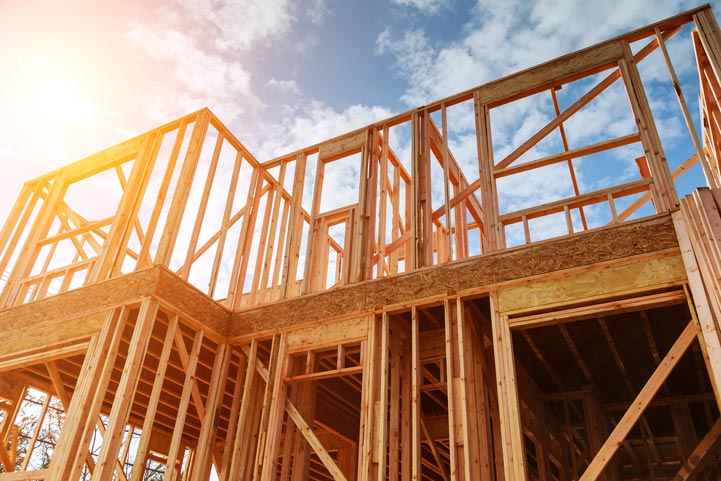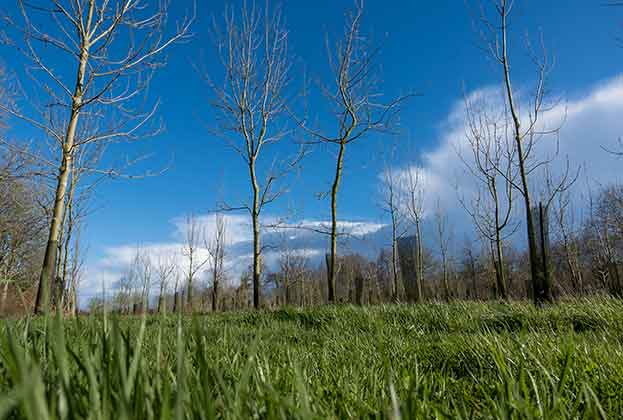Timber-frame buildings are on the rise again thanks to the environmental benefits
Timber values
Historically, the price of timber has strongly correlated to supply and demand factors, with wider economic events and extreme weather impacting prices. The table, below, illustrates recent timber price fluctuations. During 2020, despite the increase in homeowner DIY, housebuilding was halted due to Covid-19 restrictions. According to the Office for National Statistics, there was a 26% reduction in permanent dwellings completed compared to 2019, resulting in a reduction in demand and therefore the price of timber.
2021 saw a spike in timber prices. Supply was low due to a reduction in timber production during the 2020 lockdowns, while in 2021, demand boomed as many projects that had been delayed began.
During 2022 a small fall in prices was recorded, which may have been surprising as Russia halted its timber exports on 1 January 2022. Russia was the fifth largest net exporter of timber in the world in 2020, and prices were expected to rise as demand for product rose globally. However, just 1.2% of UK construction imports in 2021 came from Russia and Ukraine, including around 5% of timber imports, and therefore the impact was low. Also, the mini-budget of September 2022 created uncertainty in the UK housing sector, and the subsequent rises in inflation and mortgage rates had a negative impact on house prices as homebuyer confidence faltered. Alongside this, housebuilding targets appear to be slipping down the political agenda, with the government adding some flexibility to the original 300,000 houses per year figure. These are all factors resulting in a reduction in demand for construction timber.
Looking forwards, according to the Construction Products Association’s Winter Forecasts, construction output is expected to fall by 4.7% in 2023 before recovering slowly in 2024 with growth of just 0.6%, which could temper demand of timber for a longer period.
TIMBER USE
Recently biodiversity and carbon have grabbed the headlines, but production of quality timber remains the primary output from forestry, and wood has been used in construction for over 10,000 years. Today, timber remains one of the most environmentally-friendly materials owing to its renewability, durability and versatility, particularly when compared to alternatives, such as concrete, plastic and steel. Timber-frame buildings are on the rise, and although historically there was a stigma around the life expectancy of the construction, this appears to be waning, and the design flexibility alongside the speed of construction are boosting production and uptake.
Timber remains one of the most environmentally-friendly materials owing to its renewability, durability and versatility
Nicola Buckingham, Associate Director, Rural Research
The environmental benefits of using timber in construction include the low energy needed to manufacture the wood, the utilisation of waste wood in bioenergy and the stored carbon locked into the product itself. On top of this, timber buildings generate lower energy consumption and 20% lower carbon emissions over a building’s lifecycle compared with concrete-framed construction.
When we compare this to the cement industry, which causes between 7–8% of all man-made CO2 emissions worldwide, the question arises as to whether we are maximising our use of timber in construction, particularly with advancements in production of cross-laminated timber (CLT), which is a timber made by layering boards in alternate directions, bonded with structural adhesives. CLT has a much higher strength-to-weight ratio than concrete or steel.
PASSIVE HOUSE
New legislation in Scotland, expected to be implemented in late 2024, to build all new houses to a standard similar to Passive House has the potential to increase demand for timber. While Insulated Concrete Formwork (ICF) provides a good choice in a Passive House, timber remains the best option environmentally. Additionally, around 75% of new housing in Scotland is built with timber-frame technology already, and it is a known and trusted construction material. A timber frame reduces energy demand and has superior air tightness. CLT could also become more widely used in Passive House construction following some excellent results in America.
WHAT IS PASSIVE HOUSE?
The Passive House (or Passivhaus) concept is a design standard originating in Germany and used in construction, based upon minimal heating and cooling by using insulation, air tightness and eliminating thermal bridges. The Passive House Institute can issue certification allowing for buildings to be recognised as a Passive House. Performance targets need to be met, but there is no requirement for certain materials to be utilised.

HOMEGROWN TIMBER
An increase in timber use in construction has environmental merits on the one hand, but on the other, the UK is the second largest net importer of forest products in the world, importing £8.5 billion worth per annum. At its current levels, the UK will not be self-sufficient in timber, given that only 13% of current land use is forest cover compared to the EU average of 38%, with the majority of conifer coverage being Sitka spruce (see chart, below). However, as planting rates increase, we need to look at the balance of imports and exports and see whether we can maximise the use of homegrown stock.
Currently the UK is nearly self-sufficient in lower-grade products such as fencing, but we rely heavily on sawn wood imports, with 8.2 million cubic metres imported in 2021, as well as most of the engineered wood such as CLT. One question currently raised with UK timber is that it may be inferior in terms of strength grading compared to the denser and slower-grown competition from Europe.
To counteract this issue and reduce imports, there is an argument to be made for investment into a large-scale manufacturing plant for CLT within the UK. While an expensive investment, and perhaps more of a long-term solution, this would allow lower grade UK-grown wood to be utilised at the higher end specification in construction and maximise the increasing amount of homegrown timber.

TIMBER VS CARBON VS BIODIVERSITY
In our autumn Market in Minutes, we explored future drivers of value for the forestry sector. There are currently three potential factors – carbon, biodiversity and the traditional timber market. Commercial forestry will always have a heavy timber influence over its values; however, for smaller and amenity woodland, we may see more emphasis placed on the carbon and biodiversity aspects.
The need to prove additionality means that commercial carbon and commercial forestry schemes are increasingly incompatible, as deriving carbon income from financially-viable timber production makes additionality hard to justify.
However, in the creation of smaller amenity woodlands, there is potential for all three of these income streams to be combined, alongside creation and maintenance grants, which provides a good cash flow over the lifetime of a woodland, provided that certain criteria are met (see chart, below). For biodiversity net gain (BNG) to be incorporated alongside timber removal, it should be stated within the management plan that this will be the case, which is likely to lower the overall net gain and, therefore, the saleable units. Additionally, for BNG to be claimed alongside the WCC, the woodland needs to be established first, and then a baseline taken and biodiversity improved above and beyond the existing condition, provided there is no impact to the carbon value.
Read the articles within The Forestry Market – 2023 below.
.jpg)
